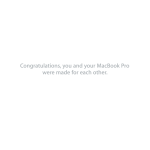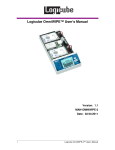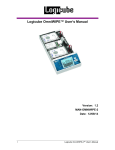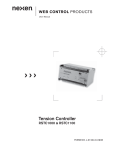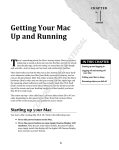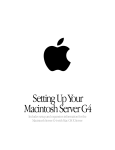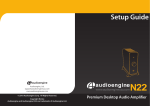Download Apple MC561LL/A User's Manual
Transcript
Congratulations, you and your Mac Pro were made for each other. Welcome to your Mac Pro. www.apple.com/macpro Mac Pro shown with LED Cinema Display, Apple Keyboard with Numeric Keypad, and Magic Mouse. OS X Lion www.apple.com/macosx Launchpad Instant access to all your apps in one place. Full screen Make apps full screen with a click. Help Center mission control Help Center launchpad Help Center full screen Mail Group your messages by conversations. iPhoto Organize, edit, and share your photos. iMovie Turn home videos into home blockbusters. GarageBand Create greatsounding songs with ease. Help Center mail iPhoto Help photos iMovie Help movie GarageBand Help record Help Center mac app store LO F R O C A EL UP Mac App Store The best way to discover and download Mac apps. M H Mission Control A bird’s-eye view of what’s running on your Mac. E R T I N O, C Contents Chapter 1: Ready, Set Up, Go 11 Setting Up Your Mac Pro 21 Putting Your Mac Pro to Sleep or Shutting It Down 24 26 28 30 32 34 Chapter 2: Life with Your Mac Pro Basic Features on the Front of Your Mac Pro Features of Your Apple Keyboard Ports and Connectors on the Back of Your Mac Pro More Ports and Connectors on the Back Internal Expansion Options Getting Answers Chapter 3: Making a Good Thing Better 39 Opening Your Mac Pro 43 Installing Memory 61 Installing Internal Storage Devices 74 Adding PCI Express Cards 79 Replacing the Internal Backup Battery Contents 5 Chapter 4: Problem, Meet Solution 82 83 85 86 91 92 92 93 95 98 99 99 102 An Ounce of Prevention Problems with Your Mac Pro Problems with Software Repairing, Restoring, or Reinstalling Mac OS X Software Checking for a Hardware Problem Keeping Your Software Up to Date Problems with Wi-Fi Communication Problems with Your Display Problems with Your Internet Connection Replacing the Apple Magic Mouse Batteries Maximizing Ethernet Performance Learning More, Service, and Support Locating Your Serial Number Chapter 5: What’s Under the Hood 104 Specifications 6 Contents Chapter 6: Last, but Not Least 116 117 120 122 123 Important Safety Information General Maintenance Understanding Ergonomics Apple and the Environment Regulatory Compliance Information Looking for Something? 130 Index Contents 7 1 Ready, Set Up, Go www.apple.com/macpro Help Center Migration Assistant Your Mac Pro features the latest computer technology, including advanced multicore processor technology, high-speed memory, PCI Express graphics and expansion slots, and internal storage, all in an anodized aluminum chassis with easy access to internal components. WARNING: To avoid injury, read all the installation instructions (and the safety information starting on page 116) carefully before you first use your Mac Pro. Make sure you look over the information in Chapter 2, “Life with Your Mac Pro,” to find out about the new features of this Mac Pro. Many answers to questions can be found on your Mac Pro in Help Center. For information about Help Center, see “Getting Answers” on page 34. 10 Chapter 1 Ready, Set Up, Go Setting Up Your Mac Pro Your Mac Pro is designed so that you can set it up quickly and start using it right away. Follow the steps on the next few pages to get started. Step 1: Position your Mac Pro and display. Pick up your Mac Pro by both of its handles using correct lifting techniques. Use correct lifting techniques when positioning your display as well. Position your Mac Pro and display so that: ÂÂ They are each on a sturdy, flat surface ÂÂ The power cable connectors don’t press against a wall or other object ÂÂ The airflow in front of, behind, and below your Mac Pro and the display is not obstructed ÂÂ The computer’s optical drive trays have space to open in front The only way to shut off power completely to your Mac Pro and display is to disconnect their power plugs from the power source. Make sure the power cords for your Mac Pro and display are within easy reach so that you can unplug them. Chapter 1 Ready, Set Up, Go 11 Step 2: Plug in the power cord. Plug the power cord completely into the recessed power cord socket on the back of your Mac Pro and plug the other end into a grounded power outlet. Power cord socket Power cord plug 12 Chapter 1 Ready, Set Up, Go Step 3: Connect the display. Connect your display as shown below. Depending on the display, you may have one or more cables to connect. Check the instructions that came with the display for additional setup information. Display ports USB port Display cable Chapter 1 Ready, Set Up, Go 13 You can connect up to three displays with Mini DisplayPort or Digital Visual Interface (DVI) connectors to the display ports on the back of your Mac Pro. The DVI display port is a dual-link port, so you can connect a 30-inch Apple Cinema HD Display. DVI display port Mini DisplayPort (2) You can also connect displays that have an Apple Display Connector (ADC) or a video graphics array (VGA) connector using one of the following adapters: ÂÂ To connect a VGA display to the DVI display port or a Mini DisplayPort, use the Apple DVI to VGA Display Adapter or the Apple Mini DisplayPort to VGA Adapter (both available separately). ÂÂ To connect an ADC display to the DVI display port, use an Apple DVI to ADC Display Adapter (available separately). The Mini DisplayPort outputs provide both video and audio output. For example, using a Mini DisplayPort to HDMI adapter and an HDMI cable, you can connect your computer to an HDTV or AV receiver that has an HDMI connector and play both audio and video. You must use the Sound pane in System Preferences to select the connected device for audio output. For more information about connecting an HDMI device, search for “HDMI” on the Mac Pro Support page at www.apple.com/support/macpro. Display adapters and other accessories for your Mac Pro are sold separately at www.apple.com/store. 14 Chapter 1 Ready, Set Up, Go Step 4: Connect an Ethernet cable or join a Wi-Fi network. To access the Internet or a network using an Ethernet cable, connect one end of an Ethernet cable to either of the Gigabit Ethernet ports on the back of your Mac Pro. Connect the other end to a cable modem, DSL modem, or Ethernet network. Gigabit Ethernet ports Chapter 1 Ready, Set Up, Go 15 Step 5: Connect the USB cable from your keyboard. Connect the keyboard cable to one of the USB ports (d) on your Mac Pro or on the display. Keyboard Mouse If the keyboard cable isn’t long enough, use the keyboard extension cable that came with your Mac Pro. Apple keyboard extension cable 16 Chapter 1 Ready, Set Up, Go Step 6: Turn on your Apple Magic Mouse. Slide the switch on the bottom of your Apple Magic Mouse to turn it on. Your wireless mouse comes with AA batteries installed, and is already paired with your Mac Pro. Pairing allows it to communicate wirelessly with your Mac Pro. Indicator light On/off switch When you first turn on your mouse, the indicator light glows steadily for 5 seconds, indicating the batteries are good. If your mouse doesn’t turn on, make sure the batteries are installed properly and charged (see page 98). The indicator light blinks until you turn on your Mac Pro and a connection is established. If you purchased an Apple Wireless Keyboard or Magic Trackpad, follow the instructions that came with the keyboard to set it up. Chapter 1 Ready, Set Up, Go 17 Step 7: Turn on your Mac Pro. Press the power button (®) on the front of your Mac Pro to turn it on. If your display must be turned on separately, turn it on by pressing its power button. Click your mouse to establish a connection with your Mac Pro. Note: If your mouse isn’t paired, follow the onscreen instructions to pair it with your Mac Pro. Step 8: Configure your Mac Pro with Setup Assistant. The first time you turn on your Mac Pro, Setup Assistant starts. Setup Assistant helps you enter your Internet information and set up a user account on your Mac Pro. You can transfer information from another Mac or PC during setup. You can also use Setup Assistant to transfer information from a Time Machine backup or other disk. You may have to update software if the other Mac doesn’t have Mac OS X version 10.5.3 or later installed. To migrate from a PC, you need to download Migration Assistant for Windows from www.apple.com/migrate-to-mac. After you start Setup Assistant on your Mac Pro, you can leave it midprocess without quitting, move to the other computer if you need to update its software, and then return to your Mac Pro to complete the setup. If you don’t use Setup Assistant to transfer information when you first start up your Mac Pro, you can do it later using Migration Assistant. Open Migration Assistant in the Utilities folder in Launchpad. For help using Migration Assistant, open Help Center and search for “Migration Assistant.” 18 Chapter 1 Ready, Set Up, Go To set up your Mac Pro: 1 In Setup Assistant, follow the onscreen instructions until you get to the “Transfer Information to This Mac” screen. 2 Do a basic setup, a setup with migration, or transfer information from a Time Machine backup or other disc: ÂÂ To do a basic setup, select “Don’t transfer now” and click Continue. Follow the remaining prompts to select your wireless network, set up an account, and exit Setup Assistant. ÂÂ To do a setup with migration, select “From another Mac or PC” and click Continue. Follow the onscreen instructions to select the Mac or PC you want to migrate information from. Your Mac or PC must be on the same wired or wireless network. You can also connect another Mac by using a FireWire cable and then restarting it in target disk mode. To restart a Mac in target disk mode, restart the computer while holding down the T key. After selecting your Mac or PC, follow the onscreen directions for migrating information. ÂÂ To transfer information from a Time Machine backup or another disk, select “From a Time Machine backup or other disk” and click Continue. Select the backup or the other disk that you want to migrate information from, and click Continue. Follow the onscreen directions for transferring the information. If you don’t intend to keep or use your other computer, it’s best to deauthorize it from playing music, videos, or audiobooks that you’ve purchased from the iTunes Store. Deauthorizing a computer prevents any songs, videos, or audiobooks you’ve purchased from being played by someone else, and frees up another authorization for use. For information about deauthorizing, choose iTunes Help from the Help menu in iTunes. Chapter 1 Ready, Set Up, Go 19 After you’ve set up your Mac Pro, check for updated software. Choose Apple () > Software Update from the menu bar and follow the onscreen instructions. Step 9: Customize Your Desktop and Set Your Preferences. You can easily make your desktop look the way you want using System Preferences. Choose Apple () > System Preferences from the menu bar or click the System Preferences icon in the Dock. System Preferences is your command center for most settings on your Mac Pro. For more information, choose Help > Help Center and search for “System Preferences” or for the specific preference you want to change. Important: You can set an option in Users & Groups preferences to help you reset your login password if you forget it. You should set your password preferences soon after setup. Need Help Setting Up? If you don’t see anything on your screen or you think your Mac Pro didn’t start up properly, check the following: ÂÂ Is your Mac Pro plugged into a power outlet? If it’s plugged into a power strip, is the power strip turned on? ÂÂ Is the power cord securely plugged into the back of your Mac Pro? ÂÂ Are the keyboard and display cables connected correctly? ÂÂ Are the brightness and contrast of the display adjusted correctly? If the display has brightness controls, adjust them. If the display has a power button, make sure the display is turned on. 20 Chapter 1 Ready, Set Up, Go ÂÂ If you still don’t see anything on your screen, restart your Mac Pro. Press and hold the power button (®) on your Mac Pro for 5 or 6 seconds, until it turns off. Press the power button (®) again to restart. ÂÂ If you see a blinking question mark on the screen or a series of flashes from the status light, see Chapter 4, “Problem, Meet Solution” on page 81. Putting Your Mac Pro to Sleep or Shutting It Down When you finish working, you can put your Mac Pro to sleep or shut it down. Putting Your Mac Pro to Sleep If you’ll be away from your Mac Pro for only a short time, put it to sleep. When your Mac Pro is in sleep, the display’s screen is dark. You can quickly wake your Mac Pro from sleep and bypass the startup process. To put your Mac Pro to sleep quickly, do one of the following: ÂÂ Choose Apple () > Sleep from the menu bar. ÂÂ Press the power button (®) on the front of your Mac Pro. ÂÂ Press the Control and Eject keys, and then click Sleep in the dialog that appears. ÂÂ Choose Apple () > System Preferences, click Energy Saver, and set a sleep timer. Chapter 1 Ready, Set Up, Go 21 To wake your Mac Pro from sleep, do one of the following: ÂÂ Press any key on the keyboard. ÂÂ Click the mouse. ÂÂ Press the power button (®) on the front of your Mac Pro. When your Mac Pro wakes from sleep, your applications, documents, and computer settings are exactly as you left them. Shutting Down Your Mac Pro If you won’t be using your Mac Pro for an extended period, shut it down. To turn off your Mac Pro, do one of the following: ÂÂ Choose Apple () > Shut Down. ÂÂ Press the Control and Eject keys, and then click Shut Down in the dialog that appears. NOTICE: Do not turn off your Mac Pro by turning off the switch on a power strip or by unplugging your Mac Pro’s power plug (unless you can’t turn off your Mac Pro any other way). Your files or system software could be damaged if your Mac Pro is not shut down properly. NOTICE: Shut down your Mac Pro before moving it. Moving your computer while the hard disk is spinning can damage the hard disk, causing loss of data or the inability to start up from the hard disk. 22 Chapter 1 Ready, Set Up, Go 2 Life with Your Mac Pro www.apple.com/macpro Help Center ports Basic Features on the Front of Your Mac Pro Optical drive Status light Second optical drive (optional) f Headphone jack ® Power button FireWire 800 ports (2) 24 Chapter 2 Life with Your Mac Pro USB 2.0 ports (2) Optical drive Your Mac Pro has a DVD±R DL/DVD±RW/CD-RW SuperDrive, which can read CD-ROM, photo CD, audio, and DVD discs. It can write music, documents, and other files to CD-R, CD-RW, DVD±R, DVD±RW, and DVD±R Double Layer (DL) discs. To open the drive, press the Media Eject key (C) on your Apple Keyboard. If your Mac Pro has a second optical drive, press the Option key and Media Eject key (C) to open it. ® Power button Press this button to turn on your Mac Pro, put it to sleep, or wake it from sleep. To restart, press and hold this button for 5 or 6 seconds until your Mac Pro turns off, and then press it again to turn it on. H Two FireWire 800 ports Connect high-speed external devices, such as FireWire digital video (DV) cameras, scanners, and external hard disk drives. You can connect and disconnect FireWire devices without restarting. Each port supports data rates up to 800 Mbit/s. d Two USB 2.0 ports Connect an iPod, iPhone, iPad, mouse, keyboard, printer, disk drive, digital camera, joystick, external USB modem, and more. You can also connect USB 1.1 devices. Your display may also have USB ports. f Headphone jack Connect headphones or earphones with a standard 3.5 mm connector. Status light A white light indicates your Mac Pro is on; a pulsing light indicates it’s in sleep. For information about a flashing status light, see “If the computer doesn’t respond or the pointer doesn’t move” on page 83. Chapter 2 Life with Your Mac Pro 25 Features of Your Apple Keyboard Escape Fast Forward Decrease brightness Mute Increase brightness Volume Down Mission Control Volume Up Launchpad Media Eject Caps Lock Function Play/Pause Rewind USB port (both sides) 26 Chapter 2 Life with Your Mac Pro Escape key (esc) Press the Escape key (esc) to close a menu without choosing an item or cancel a procedure. Brightness keys (F1, F2) Increase ( ) or decrease ( ) the brightness of your Apple display. Mission Control key (F3) Open Mission Control to get a comprehensive view of what’s running on your Mac Pro, including Dashboard, all your spaces, and all open windows. Launchpad key (F4) Open Launchpad and click an application to open any application on your Mac Pro. — Mute key (F10) Mute the sound coming from the built-in speaker, headphone jack, or audio ports. - Volume keys (F11, F12) Increase (-) or decrease (–) the volume of sound coming from the built-in speaker, headphone jack, or audio ports. C Media Eject key Press and hold the Media Eject key (C) to remove a disc. Function (fn) key Hold down to activate customized actions assigned to the function keys (F1 to F19). To learn about customizing function keys, choose Help > Help Center from the menu bar and search for “function keys.” ’ Media keys (F7, F8, F9) Rewind ( ), play or pause (’), or fast-forward ( ) a song, movie, or slideshow. Caps Lock key Press to engage caps lock so you can type capital letters. d Two USB 2.0 ports Connect a mouse and sync your iPhone, iPod, iPad, or digital camera. Chapter 2 Life with Your Mac Pro 27 Ports and Connectors on the Back of Your Mac Pro Power socket ¥ Locking latch d USB 2.0 ports (3) H FireWire 800 ports (2) G Gigabit Ethernet ports (2) 28 Chapter 2 Life with Your Mac Pro Power socket Connect the power cord that came with your Mac Pro. Don’t use an ordinary power cord or extension cord. ¥ Locking latch Lift the latch to open the side panel and access the internal components in your Mac Pro. If you’re working inside your Mac Pro and the latch is down, the drives are locked in place. You can attach a security lock (available separately) to the latch to prevent access and secure the internal components. You can also attach a security cable to the latch or through the handles and feet to protect your Mac Pro. d Three USB 2.0 ports Connect an iPod, iPhone, iPad, mouse, keyboard, printer, disk drive, digital camera, joystick, external USB modem, and more. You can also connect USB 1.1 devices. Your display may also have USB ports. H Two FireWire 800 ports Connect high-speed external devices, such as FireWire digital video (DV) cameras, scanners, and external hard disk drives. You can connect and disconnect FireWire devices without restarting. Each port supports data rates up to 800 Mbit/s. G Two Gigabit Ethernet ports with jumbo frame support Connect to a high-speed Ethernet network, a DSL or cable modem, or another computer. The Ethernet port automatically detects Ethernet devices and doesn’t require an Ethernet crossover cable. You can access the Internet or network resources such as printers and servers, and share information over the network using a CAT 5e cable. Chapter 2 Life with Your Mac Pro 29 More Ports and Connectors on the Back PCI Express expansion slots £ Mini DisplayPort (2) £ DVI display port Optical digital audio out port Optical digital audio in port , Analog audio line-in port - 30 Analog audio line-out port Chapter 2 Life with Your Mac Pro PCI Express expansion slots (3) Expand your Mac Pro by installing up to three Peripheral Component Interconnect (PCI) Express cards in the covered slots labeled 2, 3, and 4. £ Mini DisplayPort outputs Connect one or two displays that use a Mini DisplayPort connector, such as the Apple LED Cinema Display. The Mini DisplayPort outputs support both video and audio output. You can use adapters to connect your computer via the Mini DisplayPort outputs to devices such as HDTVs and AV receivers for both sound and audio output. Display adapters for your Mac Pro are available from the online Apple Store at www.apple.com/store. £ DVI display port (dual-link) Connect a display that uses a Digital Visual Interface (DVI) connector, such as the Apple LED Cinema Display, to the DVI display port. Display adapters for your Mac Pro are available from the online Apple Store at www.apple.com/store. Optical digital audio in and audio out ports Connect to decks, receivers, digital instruments, and surround-sound speaker systems using standard TOSLINK cables or fiber-optic cables with a 3.5 mm plastic or nylon optical plug. You can transfer stereo or encoded audio using the S/PDIF (Sony/Philips Digital Interface) protocol and TOSLINK cables. , Analog audio line-in port Connect self-powered microphones, MP3 and CD players, and other devices with analog capability. - Analog audio line-out port Connect self-powered speakers and other devices with analog capability. Chapter 2 Life with Your Mac Pro 31 Internal Expansion Options Optical drive carrier Drive carriers (4) Slots 2–4: PCI Express Battery (behind graphics card) Slot 1: Double-wide PCI Express graphics (graphics card installed) Memory slots (4 or 8 slots depending on model) 32 Chapter 2 Life with Your Mac Pro Optical drives Your Mac Pro comes with one or two DVD±R DL/DVD±RW/CD-RW SuperDrives. To replace an optical drive, see “Replacing an Optical Drive” on page 68. Hard disk drives or solid state drives Your Mac Pro comes with up to four drives installed. To install or replace drives, see “Installing Internal Storage Devices” on page 61. PCI Express slots Your Mac Pro has three PCI Express expansion slots. To install PCI cards in slots 2 through 4, see “Adding PCI Express Cards” on page 74. Battery Your Mac Pro uses an internal backup battery. If your Mac Pro has trouble starting up, or if the system date and time are frequently incorrect, you may need to replace the battery. See “Replacing the Internal Backup Battery” on page 79. Double-wide PCI Express graphics slot Connect up to two displays to the graphics card in the PCI Express graphics slot (slot 1). You can replace the card in this slot and install additional graphics cards in PCI slots 2 through 4. See “Adding PCI Express Cards” on page 74. Memory slots Your Mac Pro has four or eight memory expansion slots, depending on the model. To add more memory, install PC3-10600E, 1333 MHz, DDR3 ECC SDRAM UDIMMs in the memory slots. For information about the type of memory used in your Mac Pro, see “Installing Memory” on page 43. Chapter 2 Life with Your Mac Pro 33 Getting Answers Much more information about using your Mac Pro is available in Help Center and on the Internet at www.apple.com/support/macpro. To open Help Center: 1 Click the Finder icon in the Dock (the bar of icons along the edge of the screen). 2 Click the Help menu in the menu bar and do one of the following: ÂÂ Type a question or term in the Search field, and choose a topic from the list of results or choose Show All Results to see all topics. ÂÂ Choose Help Center to open the Help Center window, where you can browse or search topics. More Information For more information about using your Mac Pro, see the following: 34 To learn about See Installing drives, memory, expansion cards, or a battery Chapter 3, “Making a Good Thing Better” on page 37. Troubleshooting your Mac Pro if you have a problem Chapter 4, “Problem, Meet Solution” on page 81. Finding service and support for your Mac Pro “Learning More, Service, and Support” on page 99. Or see the Mac Pro Support website at www.apple.com/support/macpro. Using Mac OS X The Mac OS X website at www.apple.com/macosx. Or search for “Mac OS X” in Help Center. Moving from a PC to a Mac “Why you’ll love a Mac” at www.apple.com/getamac/whymac. Chapter 2 Life with Your Mac Pro To learn about See Using iLife applications The iLife website at www.apple.com/ilife. Or open an iLife application, open Help, and then type a question or term in the search field. Changing System Preferences System Preferences by choosing Apple (K) > System Preferences. Or search for “system preferences” in Help Center. Using your mouse or keyboard System Preferences and choose Keyboard & Mouse. Or open Help Center and search for “mouse” or “keyboard.” Using AirPort Extreme wireless technology The AirPort Support page at www.apple.com/support/airport. Or open Help Center and search for “AirPort.” Using Bluetooth® wireless technology The Bluetooth Support page at www.apple.com/support/bluetooth. Or open Help Center and search for “Bluetooth.” Connecting a printer Help Center and search for “printing.” FireWire and USB connections Help Center and search for “FireWire” or “USB.” Connecting to the Internet Help Center and search for “Internet.” Using a display Help Center and search for “display port.” Burning a CD or DVD Help Center and search for “burn disc.” Mac Pro specifications Chapter 5,“What’s Under the Hood” on page 103. Or see the Mac Pro specifications page at www.apple.com/macpro/specs.html. Or open System Information (in the Utilities folder in Launchpad), and then click More Info. Apple news, free downloads, and online catalogs The Apple website at www.apple.com. Instructions, technical support, and product manuals The Apple Support website at www.apple.com/support. Chapter 2 Life with Your Mac Pro 35 3 Making a Good Thing Better www.apple.com/store Help Center RAM Use the information in this chapter to customize and expand your Mac Pro to fit your needs. You can find information about important procedures in the following sections: ÂÂ “Opening Your Mac Pro” on page 39 ÂÂ “Installing Memory” on page 43 ÂÂ “Installing Internal Storage Devices” on page 61 ÂÂ “Adding PCI Express Cards” on page 74 ÂÂ “Replacing the Internal Backup Battery” on page 79 WARNING: Apple recommends that you have an Apple-certified technician install memory, PCI Express cards, and internal storage devices. To contact an Apple Authorized Service Provider or Apple for service, see “Learning More, Service, and Support” on page 99. If you install these items yourself, you risk damaging your equipment, and such damage is not covered by the limited warranty on your computer. See an Apple Authorized Reseller or Apple Authorized Service Provider for additional information about this or any other warranty question. 38 Chapter 3 Making a Good Thing Better Opening Your Mac Pro 1 Before you open your Mac Pro, shut it down by choosing Apple () > Shut Down. NOTICE: Always shut down your Mac Pro before opening it to avoid damaging its internal components or the components you want to install. Do not open your Mac Pro or attempt to install items inside it while it is on. 2 Wait 5 to 10 minutes to allow the internal components of your Mac Pro to cool. WARNING: Let your Mac Pro cool down before you touch the internal components, which may be very hot. Chapter 3 Making a Good Thing Better 39 3 Touch the metal on the outside of your Mac Pro to discharge any static electricity. NOTICE: Always discharge static before you touch parts or install components inside your Mac Pro. To avoid generating static, don’t walk around the room until you finish installing the cards, memory, or internal storage device and replace the side panel. Touch the metal case to discharge static. 40 Chapter 3 Making a Good Thing Better 4 Unplug all the cables and the power cord from your Mac Pro. WARNING: To avoid damaging internal components or the components you want to install, always unplug your Mac Pro. Don’t attempt to install items while it’s plugged in. 5 Hold the side panel and lift the latch on the back. Chapter 3 Making a Good Thing Better 41 6 Remove the side panel by pulling the top away from your Mac Pro and lifting up. Important: When you remove the side panel, hold it securely. 42 Chapter 3 Making a Good Thing Better Installing Memory Your Mac Pro comes with a minimum of 3 GB of memory in the single-processor model, or a minimum of 6 GB of memory in the dual-processor model, installed as 1 GB unbuffered ECC dual inline memory modules (UDIMMs). All installed UDIMMs must meet these specifications: ÂÂ PC3-10600E, 1333 MHz, DDR3 SDRAM UDIMMs ÂÂ Error-correcting code (ECC) ÂÂ 72-bit wide, 240-pin ECC modules ÂÂ 36 ICs maximum per ECC UDIMM NOTICE: Apple recommends that you use Apple-approved DIMMs. DIMMs from older Mac computers cannot be used in your Mac Pro. You can purchase Apple-branded memory online from the Apple Store at www.apple.com/store. When purchasing DIMMs for use in Mac computers, make sure that the memory vendor conforms to the Joint Electron Device Engineering Council (JEDEC) specification. Check with your memory vendor to ensure that the DIMMs support the correct timing modes and that the Serial Presence Detect (SPD) feature has been programmed properly, as described in the JEDEC specification. Note: Although the memory speed of the UDIMMS is 1333 MHz, they will operate at 1066 MHz or 1333 MHz depending on the processor in the computer. Chapter 3 Making a Good Thing Better 43 Before you install memory, determine whether you have a single- or dual-processor Mac Pro. Remove the side panel, following the instructions in “Opening Your Mac Pro” on page 39, and look inside: ÂÂ A quad-core or 6-core Mac Pro has one processor and four memory slots. You can install a total of up to 16 GB of memory. See “Installing Memory in a Quad-Core or 6-Core Mac Pro” on page 45. ÂÂ An 8-core or 12-core Mac Pro has two processors and eight memory slots. You can install a total of up to 32 GB of memory. See “Installing Memory in an 8‑Core or 12‑Core Mac Pro” on page 54. One processor 44 Chapter 3 Making a Good Thing Better Two processors You can also determine which Mac Pro you have by choosing Apple () > About This Mac from the menu bar. Click More Info, choose Hardware from the Contents list, and then find Number Of Processors in Hardware Overview. The quad-core and 6-core Mac Pro have one processor and the 8-core and 12-core Mac Pro have two processors. Installing Memory in a Quad-Core or 6-Core Mac Pro The quad-core and 6-core Mac Pro have four memory slots, and come with at least three 1 GB DIMMs installed. You can replace or install additional 1 GB, 2 GB or 4GB DIMMs for a total of up to 16 GB of memory. It’s important that all DIMMs installed in your Mac Pro are of the correct specifications. Use the instructions that follow to install DIMMs in a quad-core or 6-core Mac Pro. To install memory: 1 Shut down your Mac Pro, open it, and remove the side panel, following the instructions in “Opening Your Mac Pro” on page 39. WARNING: Let your Mac Pro cool down for 5 to 10 minutes before you remove the processor tray or touch the internal components. The processor tray and components may be very hot. Chapter 3 Making a Good Thing Better 45 2 Push the latches on the processor tray until they partially open. Latches 46 Chapter 3 Making a Good Thing Better 3 Pull the latches until they open all the way and release the processor tray. Chapter 3 Making a Good Thing Better 47 4 Remove the processor tray and lay it on a soft, clean cloth on the desk or work surface, to protect the tray and avoid scratching the work surface. Processor tray 48 Chapter 3 Making a Good Thing Better If you install equal-size DIMMs (for example, all 1 GB DIMMS or all 2 GB DIMMS) in your quad-core or 6-core Mac Pro, Apple recommends that you fill the slots in the order listed in the table. Slot 4 Slot 3 Slot 2 Slot 1 If you have Fill these slots Two DIMMs 1 and 2 Three DIMMs 1, 2, and 3 Four DIMMs 1, 2, 3, and 4 (all) Note:�












































































































































